High Protein Sourdough Focaccia
Looking for an easy, high-protein sourdough recipe that doesn’t need special equipment? This High Protein Sourdough Focaccia is your answer! Made with cottage cheese, it’s practically a no-knead recipe. Just stir, fold, and bake for the crispiest, fluffiest bread, rich with olive oil flavor. Perfect for sandwiches, soup, or dipping, it boasts nearly double the protein for muscle building and daily intake.

This post may contain referral links for products I love.
For The Pleasure Of Eating earns a small commission on these links at no cost to you.
- Why You’ll Love This
- The Ingredients
- Substitutions
- Equipment Used
- How to Make this
- How To Store
- FAQ
- Other Recipes You Might Enjoy
Why You’ll Love This
TL;DR
- Nearly Double the Protein: Packed with unflavored whey protein and cottage cheese for a significant protein boost, perfect for muscle building and overall health.
- Beginner-Friendly Sourdough: No special equipment or kneading needed – just mix, fold a few times, and bake for amazing results.
- Irresistible Texture & Flavor: Enjoy a perfectly crispy crust and a soft, moist, bubbly interior, rich with olive oil flavor and a subtle sourdough tang.
- Easy to Digest: Sourdough fermentation helps break down lactose, making the cottage cheese easier on your stomach.
- Incredibly Versatile: Fantastic for sandwiches, as a side with soup, or simply dipped in olive oil. Get creative with endless sweet and savory topping ideas!
Nearly Double The Protein of Classic Focaccia
I calculated both recipes using the same nutrition calculator and these are the results:
| Classic Focaccia | High Protein Sourdough Focaccia | |
| Calories | 185 | 209 |
| Total Fat | 6% | 6% |
| Cholesterol | 0% | 1% |
| Sodium | 18% | 21% |
| Carbohydrate | 12% | 12% |
| Protein | 9% | 16% |
Using unflavored whey protein powder together with creamy blended cottage cheese nearly doubles the protein content of this sourdough focaccia. This means, that together with the superpower of sourdough, making protein easier to absorb for your body, which I wrote about in detail in my post on baking with sourdough and protein, it will be absolutely fabulous for those of you who are looking to build or maintain muscle. Or anyone who wants to up their protein intake to stay healthy.
Soft With Perfectly Crispy Crust
Just like the classic Italian original, this Protein Focaccia Bread recipe comes with the crispy crust formed during baking by using lots of olive oil in the pan. The high hydration of the dough, which allows the typical large bubbles in this flavorful bread, means the inside stays perfectly moist and soft. Ideal for anything from sandwich over the perfect vehicle for mopping up flavorful dressing or soup all the way to a great and sophisticated starter, simply dipped into good quality olive oil. No matter what you use it for, this homemade bread always shines.
Ever wanted to impress your guests with a bread that looks straight out of a good Italian restaurant? This is it.
The Easiest Sourdough Bread For Beginners
Sourdough Focaccia requires no special equipment for either kneading or baking. All you need is a bowl, a spoon and either an oven proof pan (cast iron is great but not a requirement) or a casserole pan. No stand mixer or Dutch oven for this bread. No handling of steam in the oven either. The super moist dough and olive oil do all the work here.
Incredible Sourdough Flavor Instead Of Yeast
Using an active and bubbly sourdough starter eliminates the need for yeast and provides a lovely gentle tang with that typical “freshly baked bread” scent wafting through your house. And with each bite, you’ll discover sweet, malty flavors, a satisfying umami in the crust, and a subtle fresh, milky note in the crumb from the cottage cheese, creating a truly irresistible slice you’ll crave again and again.
Sourdough Makes Lactose Easier Digestible
For those of you suffering from lactose intolerance (like me) long fermented sourdough bread is a particularly good idea: The lactic acid bacteria in the sourdough break down lactose, making it easier to digest. They also produce lactase, the enzyme that helps your body to digest said lactose. So it’s double-beneficial for you.
For me, this means the cottage cheese I added to this recipe has no negative effect, and I can enjoy the protein and calcium it adds to the focaccia without regrets.
Ingredient Notes
Like most bread recipes, this one uses minimal ingredients, which means the quality of each is even more important.

- Sourdough Starter – While I really like a finer crumb in, say a sandwich bread, Focaccia is defined by its very open crumb with big bubbles. An active and optimally fed starter (Levain) is essential to achieve this. I have an easy to follow sourdough starter recipe here. You can use both rye and white flour for it.
- Strong White Flour – Using a high protein flour (Often called Bread Flour) doesn’t just feed your muscles, but also strengthens the gluten structure of the dough, leading to a beautiful bubbly and open crumb. Ideally measure by weight.
Note:
Cups, due to the possibility of compacting the flour while dragging the container through it, can give you wildly different results. Use a tablespoon to gently fill the cup with flour, then drag the back of a knife over it to level. This should give you the closest to the standard 120g per cup of flour.
Alternatively, if you have kitchen scales, assume 120g flour per cup and weigh it out.
In some of my recipes I will give gram measurements for this reason, but I mostly try to accommodate the American cup system.
- Cottage Cheese – It contributes protein, serves as part of the liquid, adding a subtle richness and a fresh, milky flavor that, for me, makes this the best focaccia I’ve ever had. You can use any fat content here. Mine is the 4% version.
- Protein Powder – The one I’m using is the unflavored whey concentrate from MyProtein.
(Full disclosure: This is neither affiliated nor sponsored. It’s simply the powder I’ve found to work and taste best after trying several.) - It gives the bread more structure and can, if you use too much, lead to a dry or squidgy bread. The dose used here works perfectly and the fat from the cottage cheese (little as it might be) counters any possible dryness.
Why Do I Add Protein?
You mean apart from the well known physical benefits of protein for the body like helping you to build muscle, keeping your bones strong and increasing satiation, meaning you stay fuller for longer and with that can maintain your weight easier?
Lesser known is, that it also effects the brain by helping it to effectively transport information through neuropathways using the amino acods found in Protein.
This even has been shown to help protect from age related dementia.If you’d like to read more about how and why I use protein, I wrote a blog post about it.
And another one about my weight loss journey, shedding 70lb within 1 year. Protein played a big part in that too!
With all those benefits, it’s no surprise that the recipes containing both sourdough and protein were popular enough for me to shift my focus.
- Salt – I’m always using Diamond Crystal Kosher salt for its flavor and because due to its lower saltiness by volume I find it easier to season perfectly. If you are using other types of salt and measuring by teaspoon, use half the amount. If using digital scales, the weight is the same.
- Olive Oil – It’s best to use extra virgin olive oil for this recipe, as it contributes so much to the flavor. I know the amount in the recipe looks like a lot but trust the process. It will give your Protein Sourdough Focaccia the typical crispy, golden crust it’s so famous for and provide incredible aroma to the bread. It won’t be all absorbed by the bread, so don’t worry about greasiness.
substitutions
- Flour – If you don’t have strong white flour (also called Bread Flour) you can use all-purpose flour but decrease the water to 300ml and judge the texture of the dough before adding more. The overall consistency may change a bit. AP flour typically results in a more tender bread and, due to its lower gluten content, may not yield as many large bubbles.
I have not yet experimented with GF flour, so if you do, I’d love to hear about your results. My favorite book on “free from” baking is “The Elements of Baking”, which has super helpful calculations for using GF flour in bread. - Cottage Cheese – Despite a slightly different fat content, 0% fat Greek yoghurt should work fine. I haven’t tried (or found) any vegan option to replace it.
- Protein Powder – In my post on Easy High Protein Sourdough Bread (the basic recipe I used to calculate the modifications here) I explain and show the differences between Whey, Casein, and Barley protein powder in bread dough. You can use either of them here, with small changes to the water content. Casein needs slightly more water, Barley slightly less.
Focaccia Topping Ideas
Focaccia is incredibly versatile, and you can top it with a million different flavors.
Here are some ideas to try out.
Savory
- Simple, yet delicious with just a little flaky sea salt (Maldon salt is particularly good here), this version is the perfect vehicle for any sandwich
- The classic is rosemary and garlic, browning and crisping up beautifully in the oven, leading to an incredible herby scent wafting through your house. Add some olives if you like for intense salty-briny bites.
- Most woody herbs work beautifully on focaccia. I prefer fresh ones, as dried herbs can burn too easily in the oven. If dried is all you have, mix them with the second portion of olive oil before drizzling it over the dough.
- Cherry Tomatoes with garlic and oregano would make this nearly into a pizza experience. Add some grated cheese, and you’ll never need takeout again.
- Garlic and parmesan is another classic, with deep, cheesy umami flavor, making it impossible to stop eating.
- Caramelized onion takes this into a different direction and makes for a fabulous pairing with soup.
- Fold in some roasted pumpkin cubes just before shaping and you have yourself an incredible fall treat.
- Or try this version in the NYT from Melissa Clark, who uses ricotta, persimmon and prosciutto as an impressive topping.
Sweet
Did you know dessert focaccia is a thing? This sourdough protein version works marvelously for sweet variations!
- Fold in blueberries or some dollops of blueberry jam before shaping, grate over a little lemon zest and maybe garnish with lemon curd after baking, for an irresistible blueberry-lemon focaccia. (This is my next Focaccia plan. Unless I get sidetracked by another temptation.)
- Brush with melted butter instead of olive oil and sprinkle with cinnamon sugar for focaccia that tastes like cinnamon rolls.
- Fold in peeled and chopped apples that you mixed with some cinnamon sugar to make caramel apple bread.
- Brush the top with melted butter, sprinkle over chopped pecans, and some sugar to get a crunchy caramelized pecan crust.
- Melted butter and a honey drizzle make a simple yet beautiful topping. A little fresh thyme would complement this perfectly, and for an extra touch, consider adding sliced peaches or even ripping some prosciutto over it before baking for crispy, salty accents.
Ok, I need to stop now, I’m getting hungry again!
Which one will you make first?
The Base Recipe I Used
If you’d like to make this without cottage cheese and protein powder, the original recipe I used as base for my modifications is from “Amy Bakes Bread”. Her recipes work without fail, so I love using them as starting point.
For example my Sourdough Croissant Cinnamon Rolls were based on her viral sourdough croissant bread, which I adore.
Equipment Used
- Large Bowl – I like using a glass bowl for better visibility of the dough. Any bowl that fits into your fridge will work
- Nutribullet – Any blender will work here. You want to blend the cottage cheese and protein powder very smoothly
- Dough Whisk or Spoon – I find a dough whisk incredibly useful for a high hydration dough like this. But a spoon works just fine.
- A 12” Cast Iron Pan or 9×13” casserole form – For the crispiest crust a cast iron pan works best. If you are using a casserole form, you might have to bake it a little longer.
 Buy Now →
Buy Now →  Buy Now →
Buy Now →  Buy Now →
Buy Now →  Buy Now →
Buy Now → How to Make this
2 Days Before Baking
Sourdough Starter(Levain)
- Using 30g of your existing starter (Levain), feed it with 50g flour and 50g water. Leave it loosely covered overnight until it has doubled in volume, is active, and bubbly.
- If you have no starter yet, here is a link on how to make your own. You just need water and flour.
- How strong your starter is depends on your flour. Use good quality flour to feed it for best results. The consistency should be like very thick, stiff pancake batter.
- How long your starter will take depends on the temperature of your house. In winter it might need longer, in summer significantly shorter.
- To determine if it’s ready check if it has doubled in volume, is actively bubbling, you see nice, strong gluten strands if gently pulling it away from the walls of the jar with a spoon and it floats on water.
- If yours seems too runny, add a bit more flour, until it gets harder to stir and leave for a few more hours.
1 Day Before Baking (Overnight Fridge Ferment)
Or Early Morning, if you want to bake on the same day.
Mix The Dough
- Check if your sourdough starter is ready by adding a dollop of it to the water. If it floats and is nice and bubbly, it’s ready. Ideally it should just have formed a bit opf a dome in its jar, when at peak activity.

- Blend the cottage cheese and protein powder with some of the water until smooth.
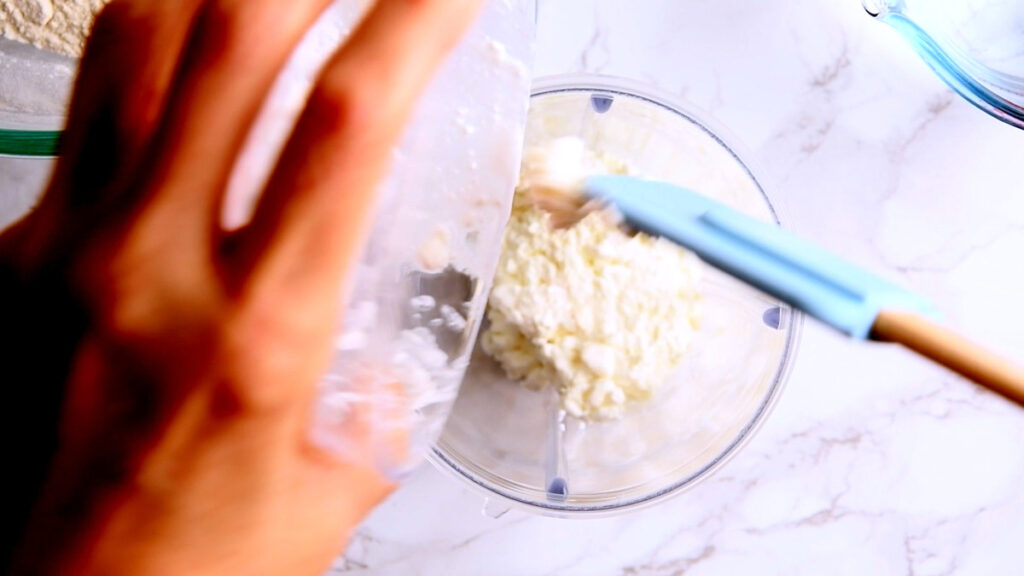


- Add the cottage cheese-protein mix to the sourdough starter together with the remaining water and stir until combined.
- In a large bowl mix the salt into your flour.
- Pour the liquids into your flour and stir until you have a shaggy dough without any dry flour bits.
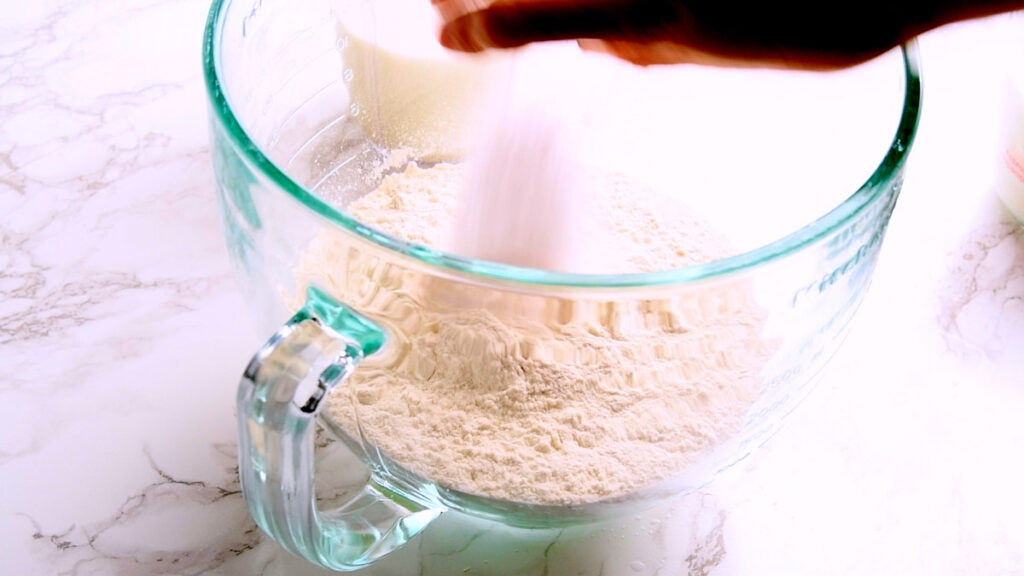
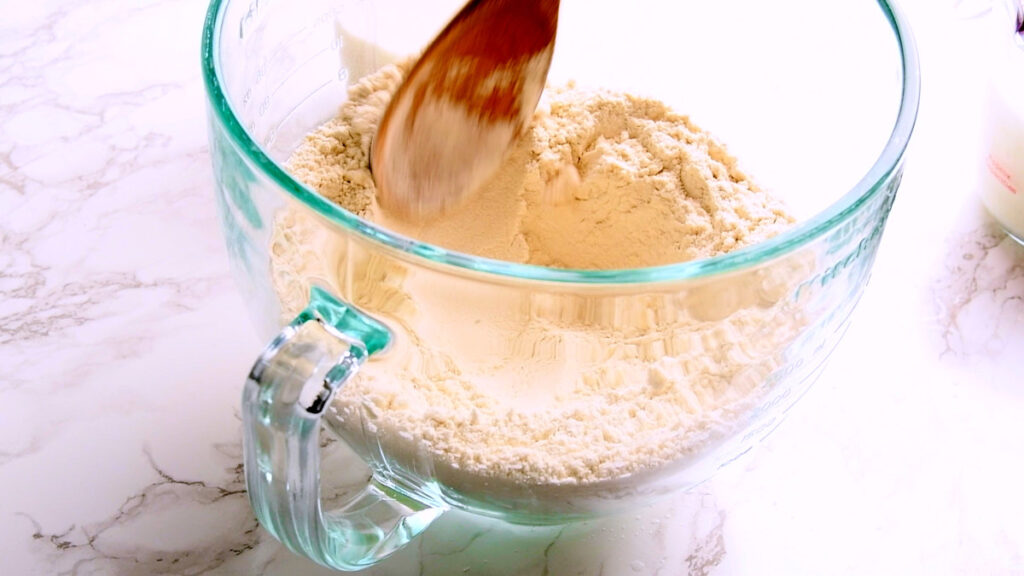

- Your dough will be very wet and sticky at this point. Don’t add more flour. This is working as intended.
- Cover with a lid, cling film, a shower cap or a damp tea towel and let it sit for about one hour.



Stretch And Fold

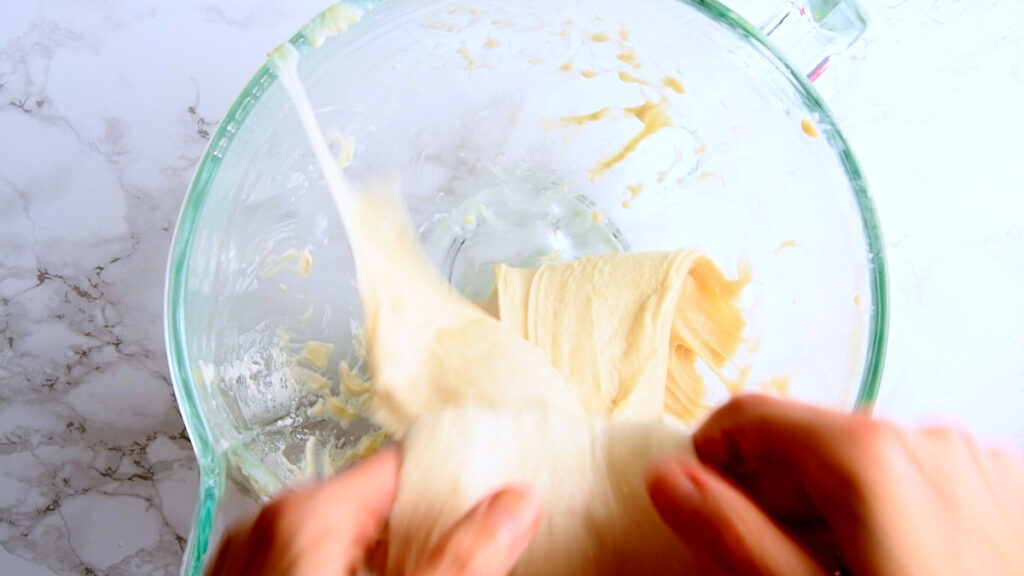
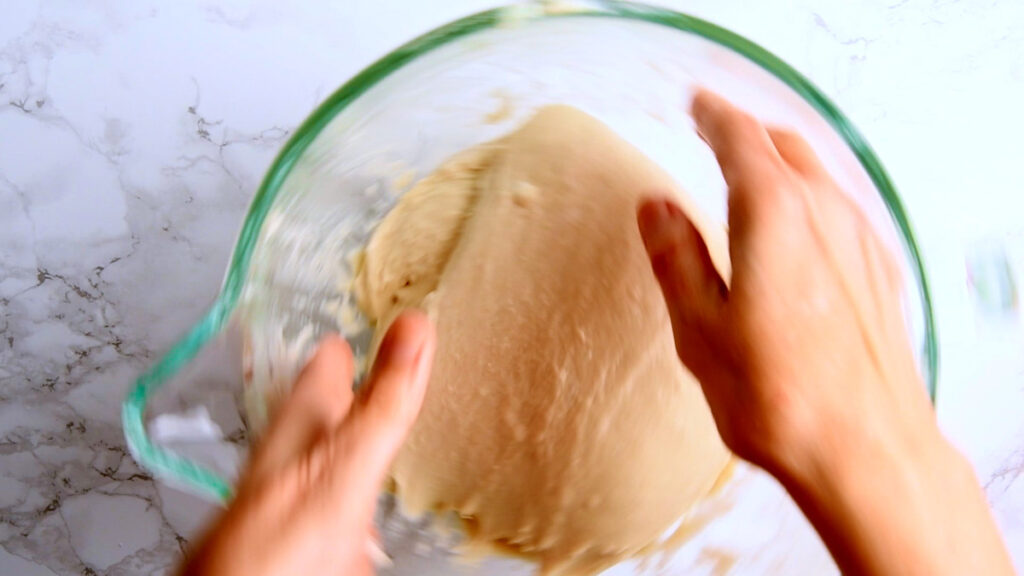
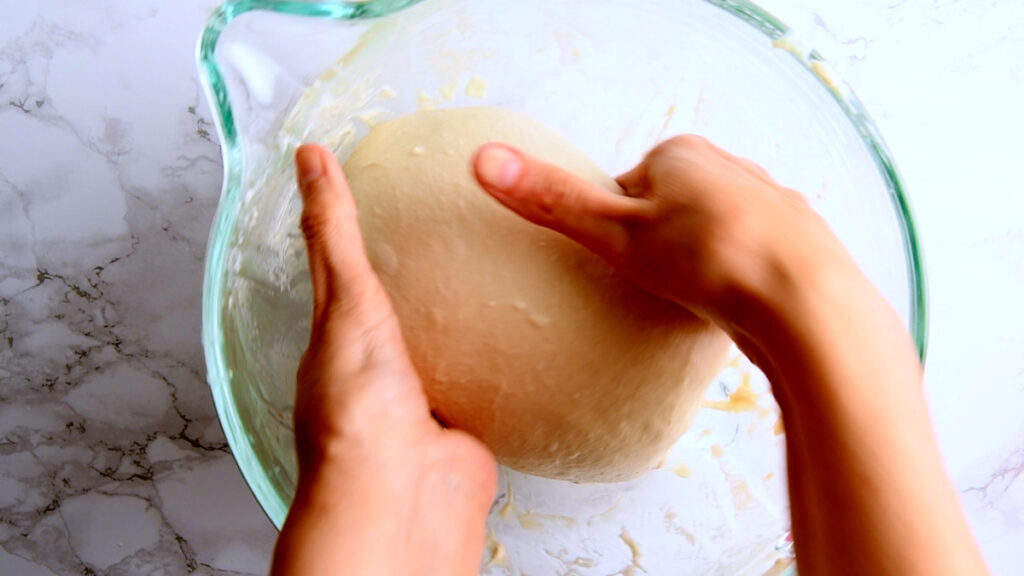
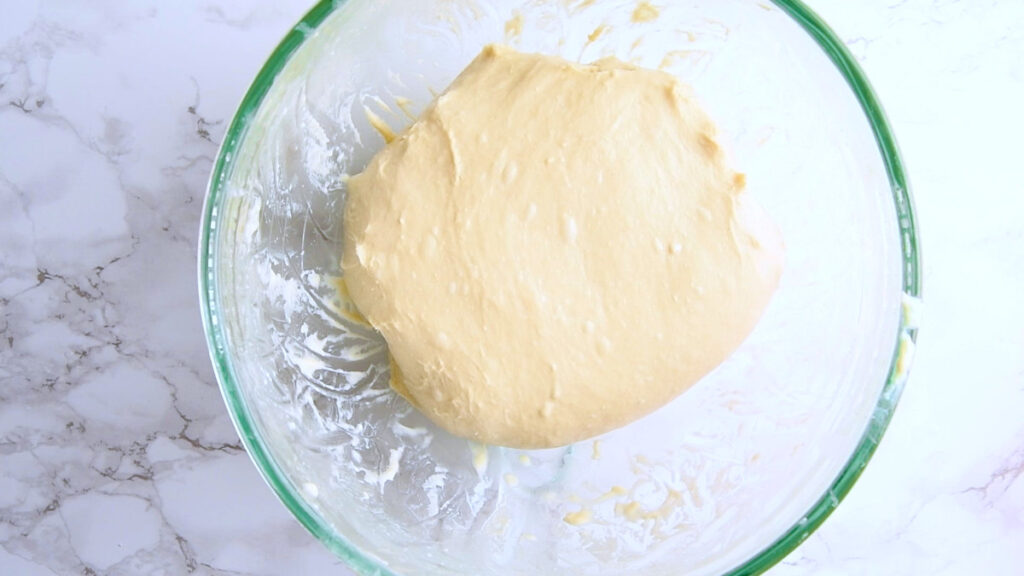
- After the first hour, start a series of 3-4 stretch and folds (or coil folds, which is what I show here).
- To do this without too much dough on your fingers, wet your hands lightly.
- Push both hands under the dough, pulling it upwards. Then fold it over itself.
- Turn the bowl 90 degrees and repeat. Do this 4 times until the bowl returns to its starting position and the dough is visibly smoother and stronger.
- Repeat every 30 minutes to 1 hour for 2-4 times or until your dough looks smooth and strong.
Bulk Ferment
Now you have two options:
Overnight Fridge Ferment
- You can cover your dough and store it in the fridge overnight for a slow fermentation (8-12 hours, or even up to 3 days if you prefer a stronger sourdough flavor or life gets in the way of baking).
Same day Baking
- You can allow your dough to ferment on the counter, for it to be ready to bake in the afternoon or evening, depending on your room temperature. This works particularly well in warm rooms.
- In this case jump straight to the shaping, as you’ll want the rise to take place in the baking dish.
- If you don’t have a warm room, but would like to bake on the same day, store your shaped dough in your closed oven (switched off) with a cup of freshly boiled water beside it, which should provide just the right temperature.
- Leave until your dough has doubled in Volume (3-8 hours)
Shaping the Focaccia
- The next morning (or right after the last stretch and fold, if you go for same day baking) take your dough out of the fridge.
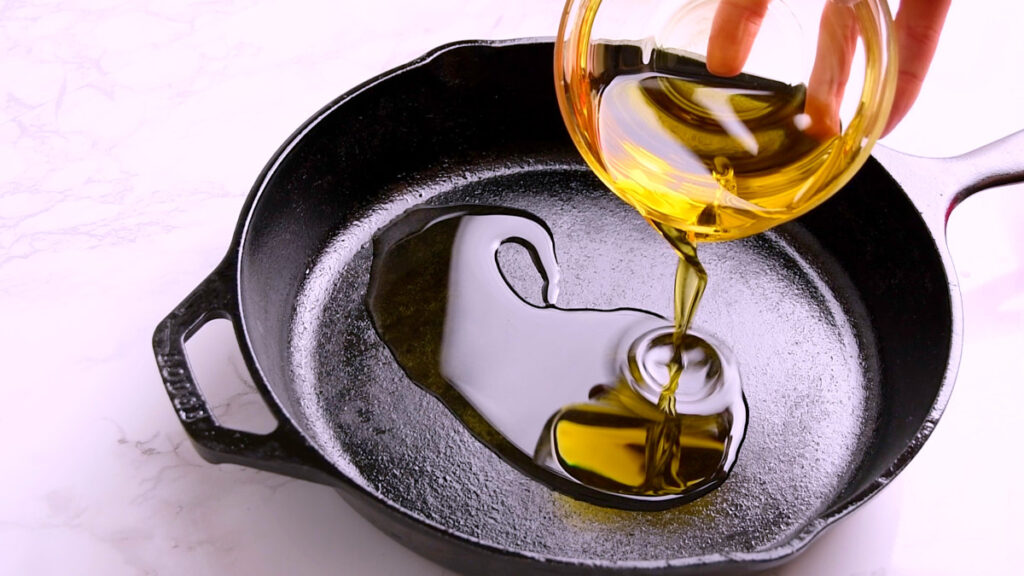
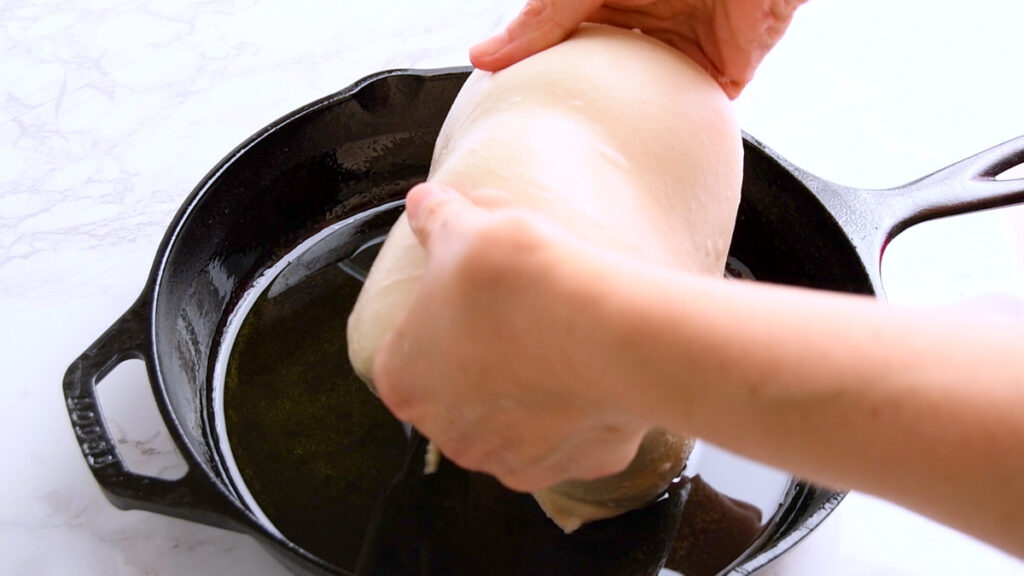

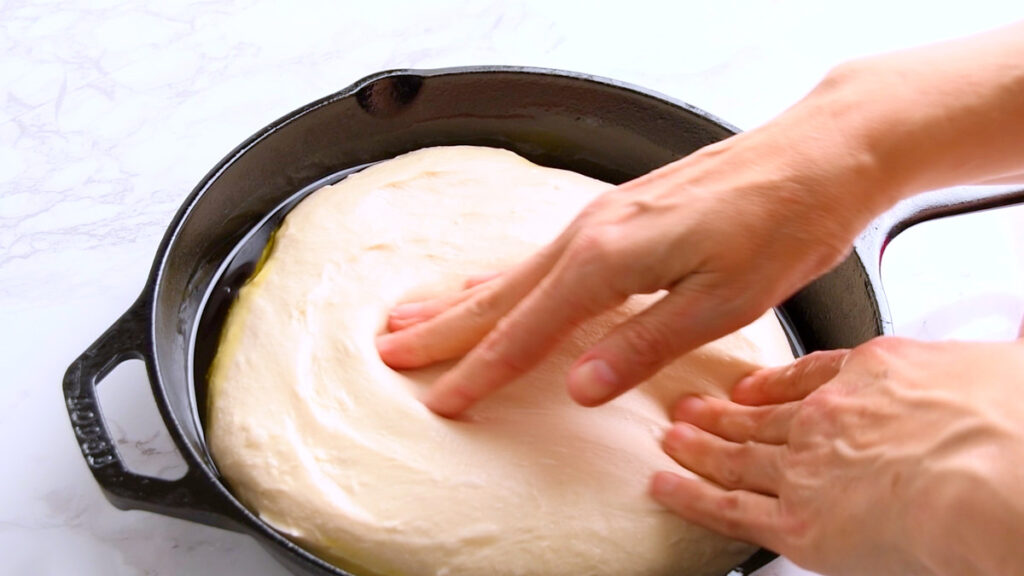
- Pour half of your olive oil into your baking dish. You could use parchment paper and then top it with the oil if you are worried about your dough sticking.
- Gently transfer your dough into the prepared baking dish and carefully stretch it to fit the dish. Don’t worry if it doesn’t reach the corners. It will mold itself while rising.
- You can push your hands under the dough and pull from the center towards the sides for even distribution.
- Cover again and leave for 3-6 hours or until doubled in volume, jiggly and really bubbly.
- This is the secret to the perfect Focaccia: Patience.
I baked one of mine too early and while it still tasted amazing, it didn’t have the characteristic huge bubbles and airy texture. You want to go nearly to the state of over proofing. Further than with classic sourdough bread. - If you feel it’s not rising well, give it either more time or use the oven method described above to give it a bit of a boost.
This is how it should look. The pan nearly full with the dough showing clearly visible bubbles.
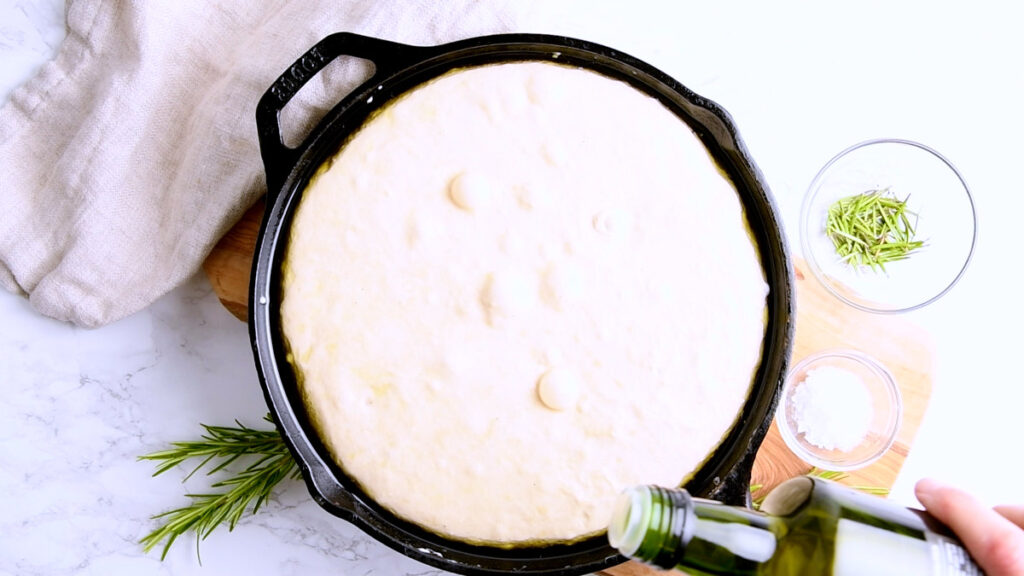
Bake your Protein Sourdough Focaccia
- Pre-heat your oven to 430°F/225°C
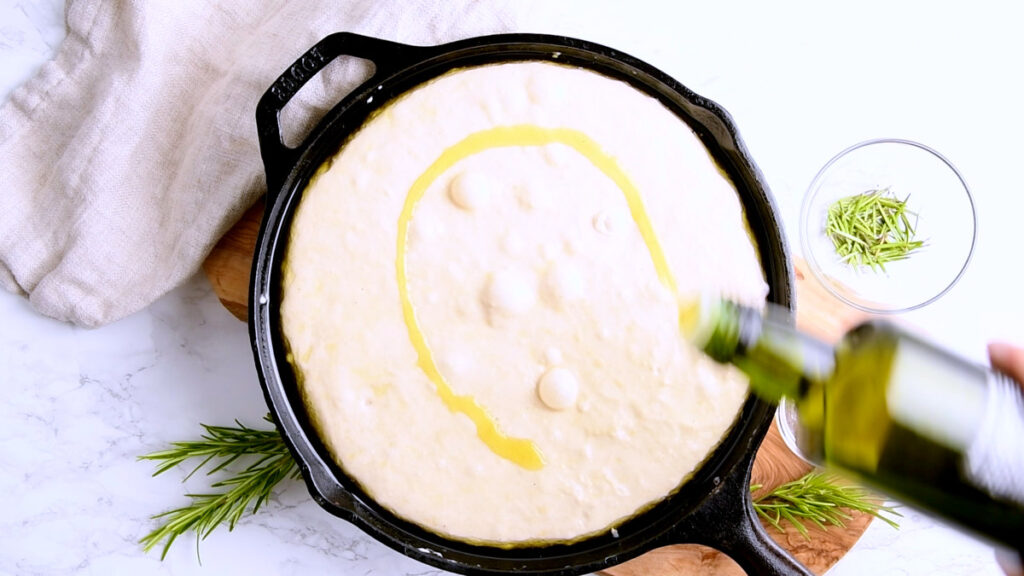
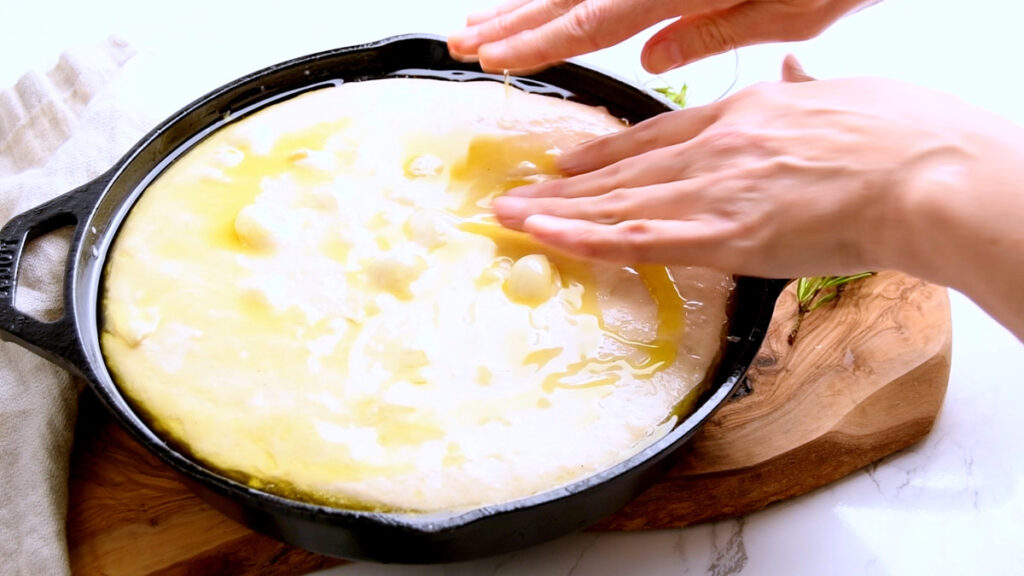
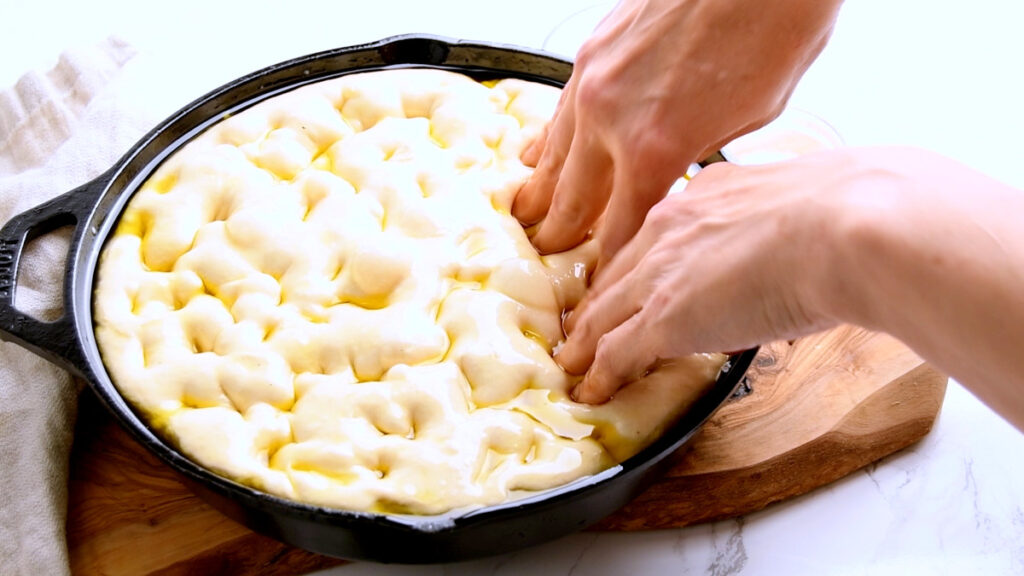
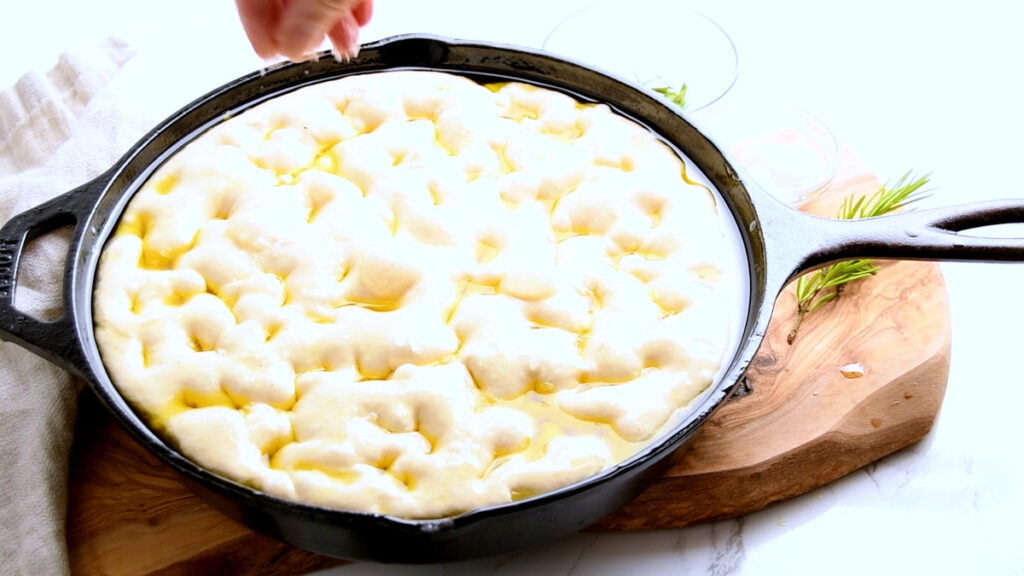
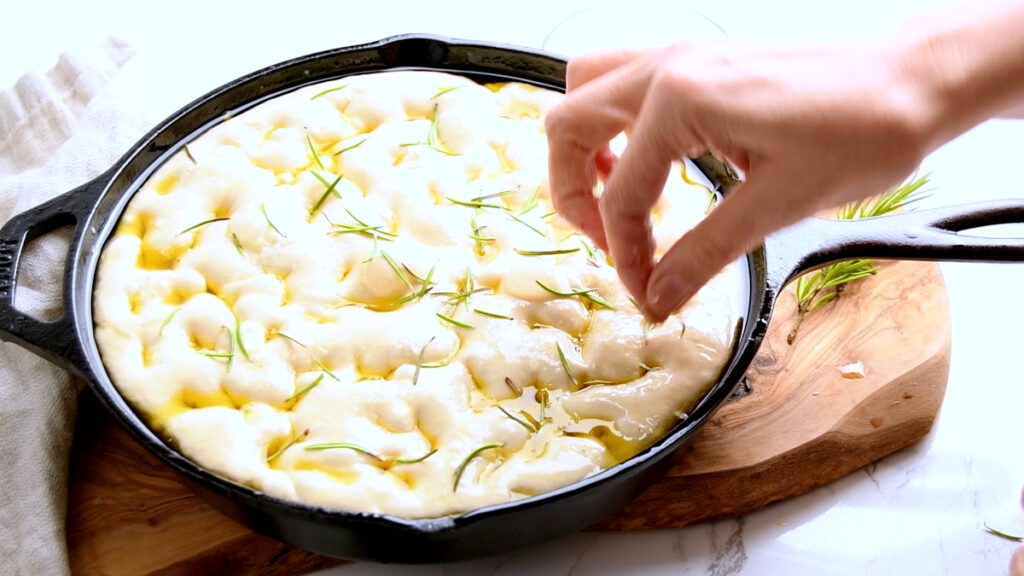
- Pour the remaining oil over the dough
- Using your hands, gently spread the oil over the dough.
- Start dimpling the dough, to create the typical Focaccia surface by pushing your fingertips deep into the dough and continue until you have an even dimple pattern.
- Sprinkle with a little flaky salt and your favorite toppings. I used fresh rosemary.
- Bake for 20-25 minutes, or until golden brown and baked through
- Allow to cool in the pan for about 10 minutes, then transfer to a wire rack.
- Enjoy warm or at room temperature as a stunning starter, sandwich or side to mop up any sauce.
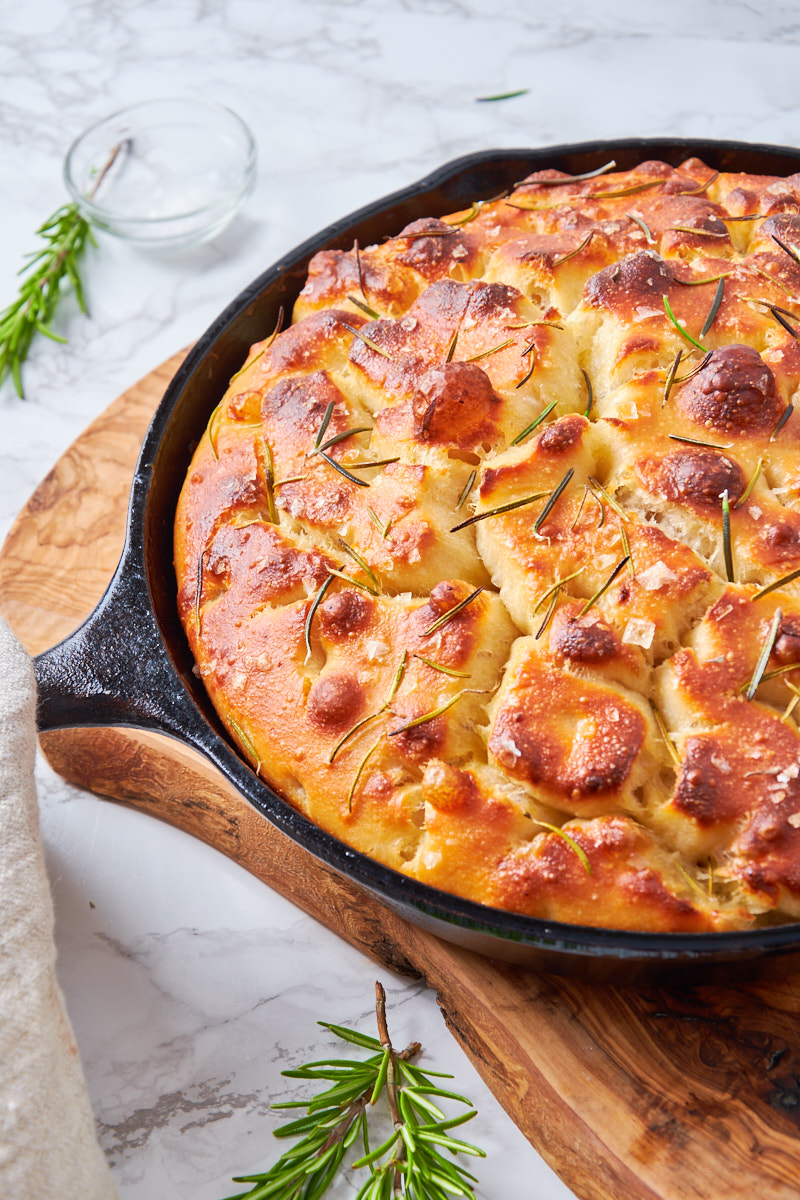
Watch The Video Here:
How To Store
This Protein Sourdough Focaccia keeps for maximum 3 days in a lidded bread tin on the counter. Or up to 5 days in the fridge.
It freezes incredibly well too for up to 6 months and can be easily reheated in the air fryer. I like to dampen it first with a little water, for the perfect freshly baked crispy texture and soft, fluffy insides.
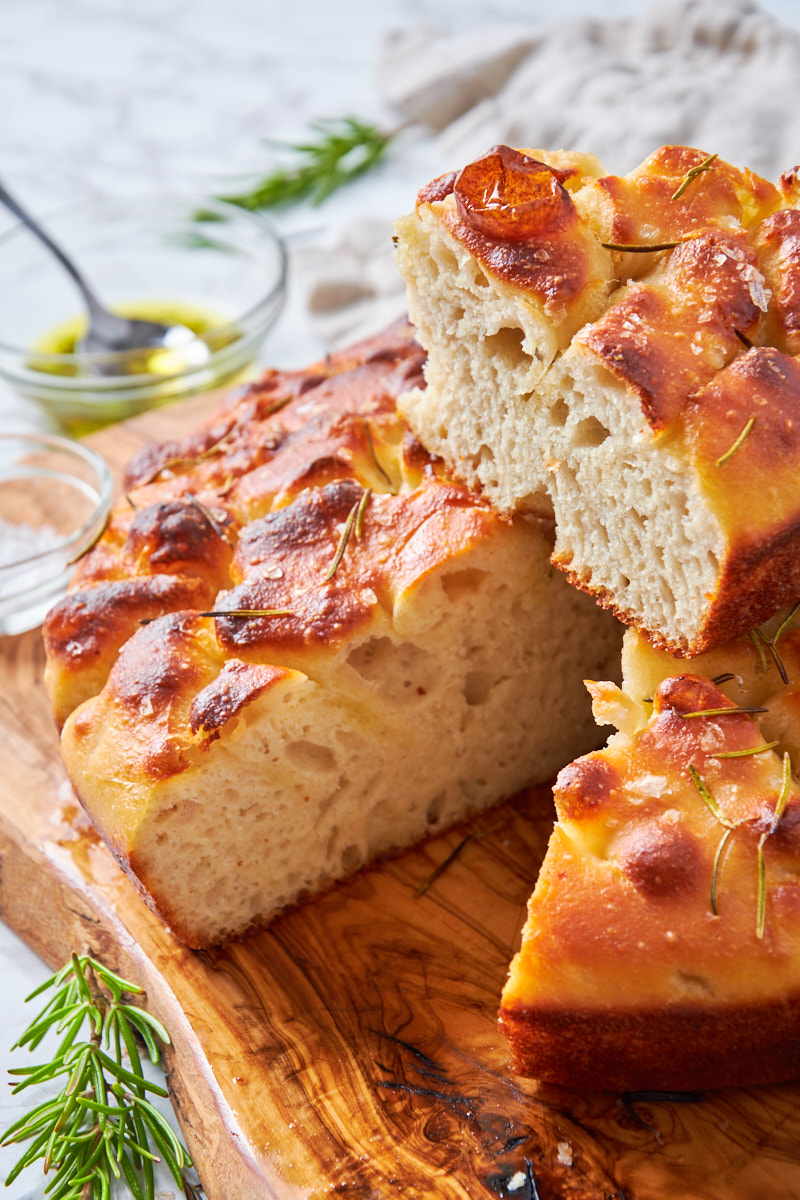
FAQ
You can leave the dough in the fridge for up to 3 days. The tangy flavor will get more intense (which you might enjoy!). Just make sure to take it out of the fridge and give it plenty of time to warm up and rise before you bake it.
You can, but be aware that cast iron and ceramic retain cold for a while, meaning the rising time outside the fridge might be significantly longer. I made a test version this way and had to bake it before it was perfectly proofed due to time constraints. While it was still delicious, it lacked the characteristic large bubbles.
You can. Since the cottage cheese is only about 80% water and 20% solids, you need to swap for 112ml water instead of the 140g cottage cheese and possibly up the flour (or protein powder) by 1 tbsp. Your bread might taste slightly different but will still be delicious.
Since one of the main characteristics of Focaccia are the big bubbles, which you only get from very active starter, I wouldn’t advise it. If you do however, be sure to let it rise even longer outside of the fridge. It might not be as fluffy, but the flavor will still be lovely.
While theoretically possible, it’s highly unlikely with focaccia in particular, as it truly benefits from a long rise. I’ve let mine rise for 10 hours outside the fridge when I got busy, and all that resulted were huge, bouncy bubbles and an incredible rise. For this bread, it’s generally better to aim for a longer rise than a shorter one for the best results.
Some bakers even advise to turn any overproofed dough into focaccia, as the best way to use it.
Now I’d love to hear from you in the comments!
Have you tried this? Did you enjoy it?
What other recipes would you like to see?
And if you enjoyed this recipe, please consider rating, sharing, or leaving a comment – your feedback truly helps my blog grow!
Other recipes you might enjoy

An easy high protein sourdough bread.
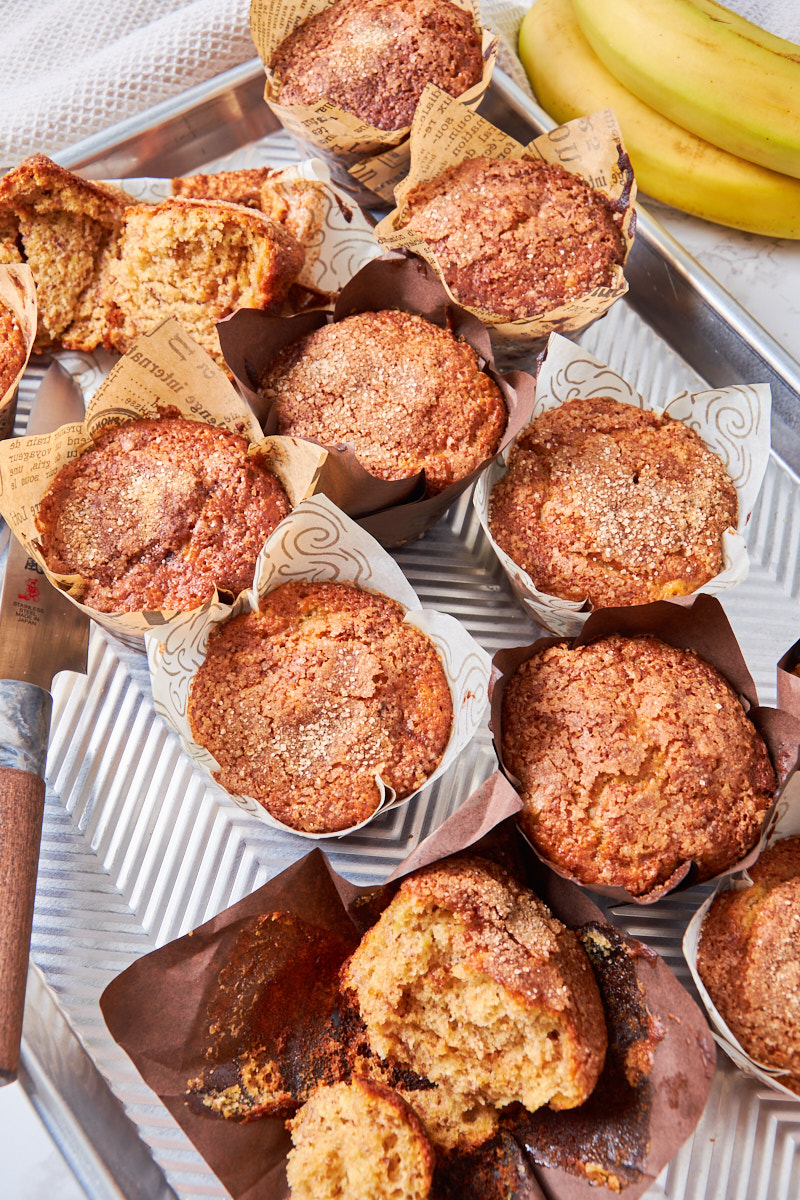
Soft and fluffy Cinnamon Banana Protein Muffins to use up your sourdough discard.

A surprising summer dessert with hidden protein, no one will notice this Strawberry Pretzel Pie is actually good for them.

High Protein Sourdough Focaccia
- Total Time: 2 days 55 minutes
- Yield: 12 slices 1x
- Diet: Vegetarian
Description
Looking for an easy, high-protein sourdough that doesn’t need special equipment? This High Protein Sourdough Focaccia is your answer! Made with cottage cheese, it’s practically a no-knead recipe. Just stir, fold, and bake for the crispiest, fluffiest bread, rich with olive oil flavor. Perfect for sandwiches, soup, or dipping, it boasts nearly double the protein for muscle building and daily intake.
Ingredients
Dough
100g ripe, bubbly sourdough starter (scant 1/2 cup)
365ml water (1 1/2 cups)
500g strong white flour (about 3 1/2 cups. Use digital scales in bread recipes for best results)
140g cottage cheese (1/2 cup+ 2 tbsp)
50g whey protein powder, unflavored (2 scoops)
13g salt (3 1/2 tsp Kosher salt.)
60ml olive oil (1/4 cup)
Toppings
1–2 tsp flaky salt
Fresh herbs like rosemary or thyme (optional)
Sliced or roasted garlic cloves (optional)
Instructions
Sourdough Starter (Levain)
Prepare your starter 2 days before you plan to make your Focaccia.
- Using 30g of your existing starter (Levain), feed it with 50g flour and 50g water. Leave it loosely covered overnight until it has doubled in volume, is active, and bubbly.
- How strong your starter is depends on your flour. Use good quality flour to feed it for best results. The consistency should be like very thick, stiff pancake batter.
- How long your starter will take depends on the temperature of your house. In winter it might need longer, in summer significantly shorter.
- To determine if it’s ready check if it has doubled in volume, is actively bubbling, you see nice, strong gluten strands if gently pulling it away from the walls of the jar with a spoon and it floats on water.
One Day Before Baking (Overnight Fridge Ferment)
Or Early Morning, if you want to bake on the same day:
Mix The Dough
- In a large bowl mix the salt into your flour.
- Blend the cottage cheese and protein powder with some of the water until smooth.
- Add the cottage cheese-protein mix to the sourdough starter together with the remaining water and stir until combined.
- Pour the liquids into your flour and stir until you have a shaggy dough without any dry flour bits.
- Your dough will be very wet and sticky at this point. Don’t add more flour. This is working as intended.
- Cover with a lid, cling film, a shower cap or a damp tea towel and let it sit for about one hour.
Stretch And Fold
- After the first hour, start a series of 3 stretch and fold.
- To do this without too much dough on your fingers, wet your hands lightly.
- Push both hands under the dough, pulling it upwards. Then fold it over itself.
- Turn the bowl 90 degrees and repeat. Do this 4 times until the bowl returns to its starting position and the dough is visibly smoother and stronger.
- Repeat every 30 minutes to 1 hour for 2-4 times or until your dough looks smooth and strong.
Bulk Ferment
Now you have two options:
- You can cover your dough and store it in the fridge overnight for a slow fermentation (8-12 hours, or even up to 3 days if you prefer a stronger sourdough flavor or life gets in the way of baking).
- Or you can allow your dough to ferment on the counter, for it to be ready to bake in the afternoon or evening, depending on your room temperature. This works particularly well in warm rooms.
- In this case jump straight to the shaping, as you’ll want the rise to take place in the baking dish.
- If you don’t have a warm room, but would like to bake the same day, store your shaped dough in your closed oven (switched off) with a cup of freshly boiled water beside it, which should provide just the right temperature.
- Leave until your dough has doubled in Volume (3-6 hours)
Shaping the Focaccia
- The next morning (or right after the last stretch and fold, if you go for same day baking) take your dough out of the fridge.
- Pour half of your olive oil into your baking dish. You could use parchment paper and then top it with the oil if you are worried about your dough sticking.
- Gently transfer your dough into the prepared baking dish and carefully stretch it to fit the dish. Don’t worry if it doesn’t reach the corners. It will mold itself while rising.
- You can push your hands under the dough and pull from the center towards the sides for even distribution.
- Cover again and leave for 3-6 hours or until doubled in volume, jiggly and really bubbly.
- This is the secret to the perfect Focaccia: Patience.
I baked one of mine too early and while it still tasted amazing, it didn’t have the characteristic huge bubbles and airy texture. You want to go nearly to the state of over proofing. Further than with classic sourdough bread.
If you feel it’s not rising well, give it either more time or use the oven method described above to give it a bit of a boost.
Bake your Protein Sourdough Focaccia
- Pre-heat your oven to 430°F/225°C
- Pour the remaining oil over the dough
- Using your hands, gently spread the oil over the dough.
- Start dimpling the dough, to create the typical Focaccia surface by pushing your fingertips deep into the dough and continue until you have an even dimple pattern.
- Sprinkle with a little flaky salt and your favorite toppings.
- Bake for 20-25 minutes, or until golden brown and baked through
- Allow to cool in the pan for about 10 minutes, then transfer to a wire rack.
- Enjoy warm or at room temperature as a stunning starter, sandwich or side to mop up sauce.
Notes
How To Store
This Protein Sourdough Focaccia keeps for maximum 3 days in a lidded bread tin on the counter. Or up to 5 days in the fridge.
It freezes incredibly well too for up to 6 months and can be easily reheated in the air fryer. I like to dampen it first with a little water, for the perfect freshly baked crispy texture and soft, fluffy insides.
- Prep Time: 30 minutes
- Fermentation Time: 24 hours
- Cook Time: 25 minutes
- Category: Sourdough Bread
- Method: Bake
- Cuisine: Italian


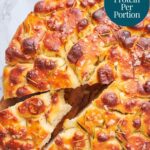
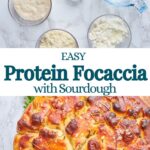


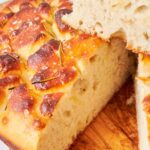
This sourdough focaccia is incredible! So easy to make and tastes amazing. Bookmarking this recipe to my favorites folder!
Oh good! I’m always happy to hear when my recipes end up in favorites. Thank you so much. 🙂
This was the perfect bread to make with my 10-year-old. The whole family loved it too!
Ahh, I bet! I always loved to bake with my grandma when I was a kid (my mom wasn’t a fan).
Playing with a lovely sourdough and oil can only be fun for the little ones. 🙂
I love the recipe for my little friend in the fridge: sourdough starter! I really loved how moist and fluffy this focaccia was, yet still got all the crunch and flavour! Super recipe, thanks!
Have you named your starter yet? Do you also feel bad if you have to leave him alone for a few days?
Ahem…sorry, maybe just me. 😉
So happy you enjoyed the recipe!
This high-protein sourdough focaccia is so good that I made it with my sourdough starter. great with a bowl of soup.
Thank you, I love it with soup too. 🙂
The sourdough was light, airy, and flavorful. I have already made it twice.
Oh good, that’s what I love to hear! Thanks so much for letting me know. 🙂
The crust is divine, and the texture turned out so soft and airy. This one’s definitely going into my regular baking lineup.
Oh good, thank you so much for letting me know. 🙂